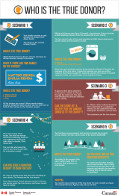What you need to know to issue an official donation receipt
Is the donation a gift?
To issue an official donation receipt, a registered charity must determine whether or not the donation constitutes a gift (see What is a gift).
Who is the donor?
A registered charity can only issue an official donation receipt to the individual or organization that made the gift, and the name and address of the donor must appear on the receipt. A charity cannot issue an official donation receipt in the name of anyone but the true donor.
Graphic educational tool: Who is the true donor? (PDF)
Image description
Who is the true donor?
SCENARIO 1
Your charity receives a cash donation by cheque from Albert Smith.
The name on the cheque is Albert Smith.
Who is the true donor?
Albert Smith is the true donor, and you can issue an official donation receipt in his name.
What if there are two names on the cheque? Who is the true donor?
- Matteo Renda
- Emilia Renda
- Both
All the choices are correct. When people make a donation using their joint account, you can write one or both of their names on the donation receipt.
SCENARIO 2
Miguel and Hanna own Clean It Yourself, a laundromat. Hanna donates a used washing machine from the laundromat to your charity. The fair market value of the used machine is $100. Hanna asks you to her name on the donation receipt.
Who is the true donor?
- Hanna
- The business Clean It Yourself
Since the used washing machine is the property of Clean It Yourself, the business is the true donor. Unless the business can give you written evidence that Hanna bought the washing machine from Clean It Yourself using her funds, you cannot issue a tax receipt to Hanna.
SCENARIO 3
A grocery store asks customers to donate to a charity as they go through the check-out. The store then donates the amount collected to your charity.
Can the store get a receipt for the amount donated to the charity?
No. When a store collects donations from customers for a registered charity, it is the customers who are making the donations, not the store.
The customers are the true donors.
SCENARIO 4
Chun has a party at her house. She tells her friends that she is collecting funds for your registered charity and asks them to donate. Chun raises $45. The next day she takes this cash to your charity and asks for a donation receipt.
Can you issue a donation Receipt to Chun for $45?
No. Chun’s friends knew that they were donating to your charity. The friends are the true donors. Since Chun doesn’t know who put money in the box, you cannot name the true donors, and hence cannot issue a receipt.
SCENARIO 5
Two brothers co-own property and decide to donate the property to your charity. The fair market value of the land is $200,000.
Who is the true donor?
According to the property title, each brother owns 50% of the land. Both brothers are true donors.
Do you issue one or two donation receipts?
You issue two donation receipts, one to each brother. Each receipt will reference the full value of the property and identify the donation as being 50% of the full value, or $100,000.
Note:
You need to have evidence of the true donor for every receipt you issue. The Canada Revenue Agency may ask you for this.
What is the eligible amount of the gift for receipting purposes?
Once a registered charity has determined that a gift has been made, it must determine the eligible amount of that gift for receipting purposes in order to issue an official donation receipt.
To determine the eligible amount of a gift, a charity must know:
- The fair market value of the donated property
- The fair market value of any advantage provided to the donor
Before the charity can issue an official donation receipt, any advantage must normally be deducted from the fair market value of the donation.
What is the date of donation?
The date of donation is the date the gift is actually received by the charity. However, when a charity receives a donation by mail, the Canada Revenue Agency considers the date of donation to be the date of the postmark on the envelope. The charity should keep the stamped envelope as part of its books and records.
References
Page details
- Date modified:
